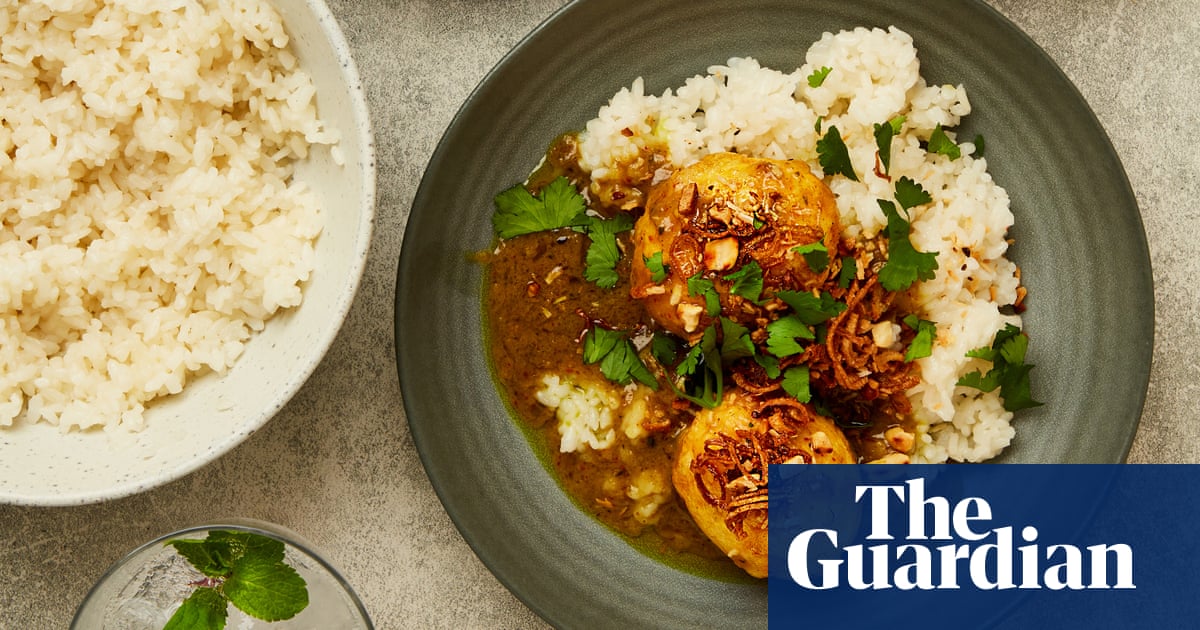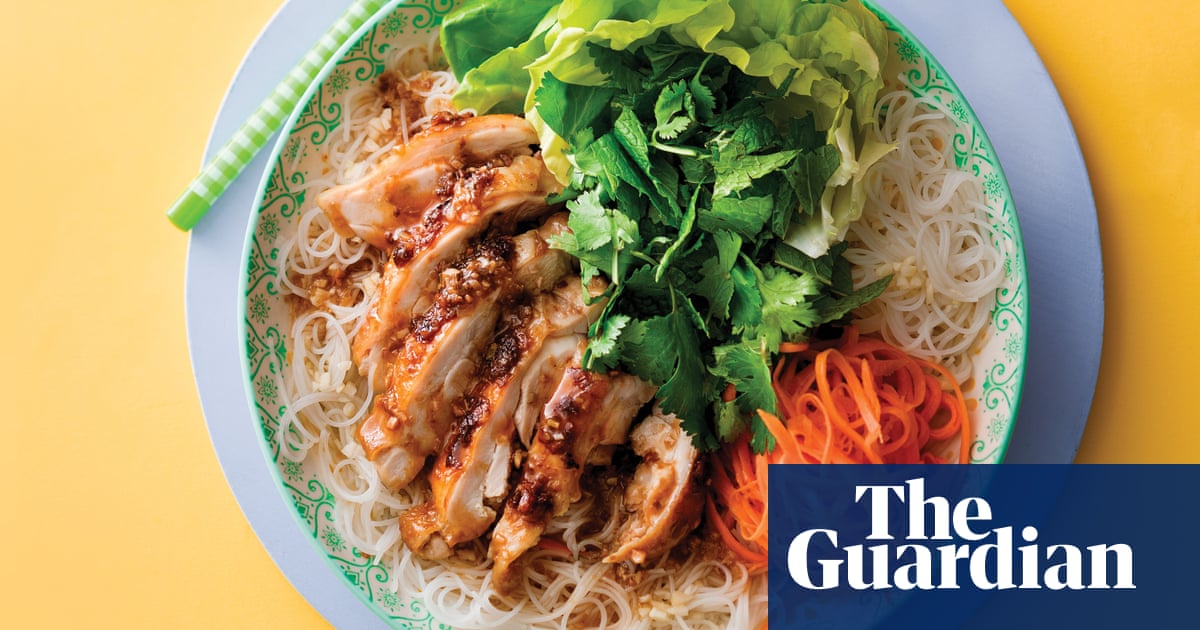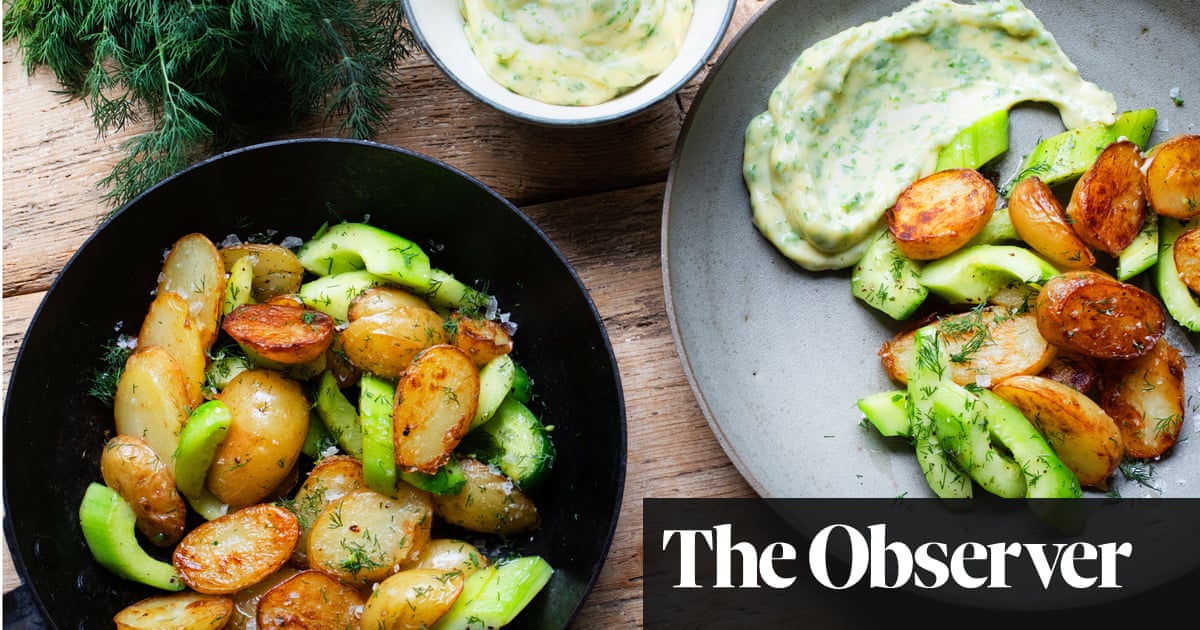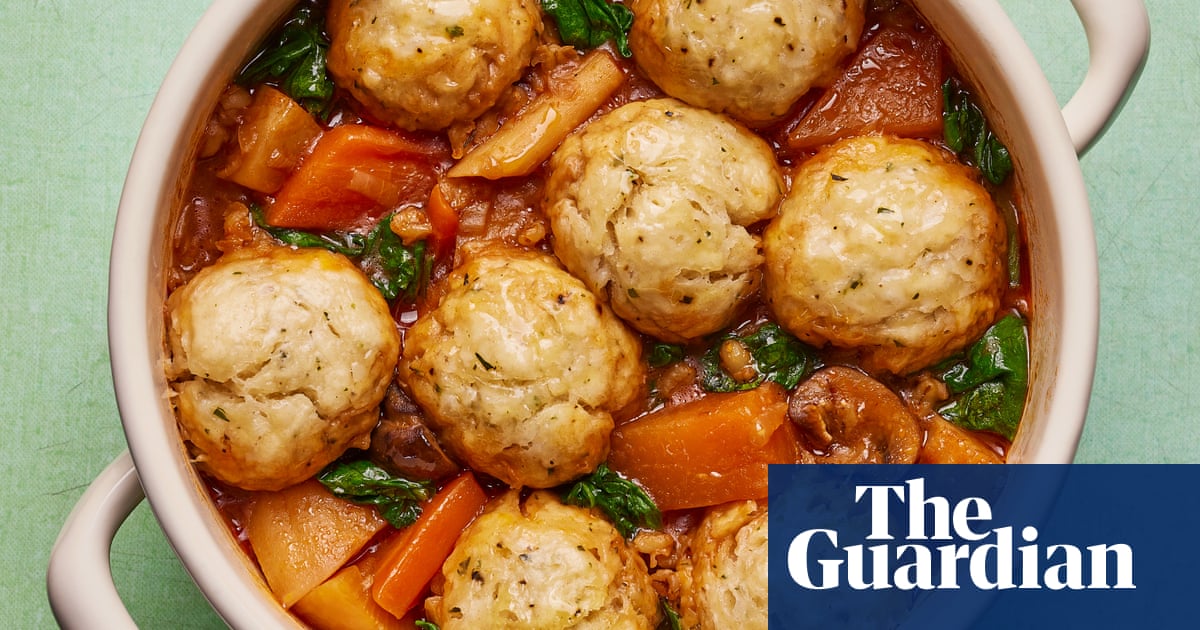
ne of the questions that’s hardest to answer about a book is, “What are your favourite recipes from it?” I’m ruthless about the recipes I include: only those I love enough to cook, with undimmed enthusiasm, on repeat make the cut. But within that, of course, there are categories of fondness, and the dishes that follow are those to which I return with greedy glee whenever I want sumptuous comfort allied with flavour for a supper that bolsters quite as much as it soothes. With thanks to Ash Sarkar and Felicity Cloake for inspiration for the fish finger bhorta and ruby noodles, respectively.
Fried chicken sandwich (pictured above)
Prep 5-10 min
Marinade 4 hr+
Cook 15 min
Serves 1, ecstatically
75ml kefir, buttermilk or plain yoghurt
½ tsp hot smoked paprika, plus ¼ tsp extra to season the flour
½ tsp fine sea salt, plus ¼ tsp extra to season the flour
1 tsp lemon juice
½ tsp dijon mustard
½ tsp maple syrup
1 fat garlic clove
1 small chicken thigh fillet
4-5 tbsp (50g) plain flour
Sunflower oil, for frying – about 1½ litres for a 22cm pan, more for a wok
To assemble
4 tbsp garlic mayonnaise
1 tsp crispy chilli oil or other chilli sauce
¼ tsp honey
1 burger bun (or 2 slices white bread)
A few leaves of iceberg lettuce, shredded
Kimchi or pickles of your choice
Pink-pickled onions (see fish finger bhorta recipe above)
Pour the kefir, buttermilk or yoghurt into a small dish and stir in the half-teaspoon of hot smoked paprika, half a teaspoon of salt, the lemon juice, mustard and maple syrup. Peel the garlic and mince or grate it in, too. Give everything a good stir, then add the chicken and turn it in the marinade so it’s well coated. Cover, then refrigerate and leave for at least four hours or up to two days. (If you simply cannot wait that long, leave the chicken in its marinade out on the kitchen counter for 20-40 minutes.)
Take the chicken out of the fridge in good time to get to room temperature before you start to cook it.
Mix the flour in a shallow dish with the remaining quarter-teaspoons each of hot smoked paprika and salt. Lift the chicken out of the marinade, but don’t shake it off. Dredge both sides of the chicken in the seasoned flour, then dip briefly back into the marinade and dredge again in the flour: this double-dredging is essential to get a thick, shaggy coating. You can leave the coated chicken in the flour dish until you fry.
Mix the garlic mayonnaise with the chilli oil and honey, and spread over both cut sides of a split burger bun (or one side of each of two slices of bread). Put a plate lined with kitchen paper by (but not dangerously near) the hob, so you can get rid of any excess fat once the chicken’s cooked.
Pour enough oil into your chosen pan to come about 3½cm up the sides, and heat until a small piece of bread turns golden and crisp almost instantly; if you want to be precise, and have a food thermometer, you want the fat to be at 190C when the chicken goes in (and about 180C as it cooks).
Using tongs, gently lower the chicken into the hot oil and cook for three to four minutes on each side, by which time the coating should be deep gold and very crisp, and the chicken completely cooked through. Remove to the waiting paper-lined plate, remembering to take the pan off the heat, and leave to stand for a couple of minutes while you shred some iceberg lettuce and get out your pickles.
Put a handful of shredded lettuce on top of the mayo on the bottom half of the bun (or one slice of bread), top with the fried chicken, and add kimchi, pink-pickled onions and any other pickles you want. Scatter with a bit more lettuce and squidge on the top of the bun (or second slice of bread). Go in cautiously: I have more than once burned my mouth.
Ruby noodles
Prep 5-10 min
Cook 15 min (plus cooling time)
Serves 4
450ml beetroot juice, from a carton
2 limes
2 fat garlic cloves
2 tsp grated fresh ginger
2 tsp sea salt flakes (or 1 tsp fine sea salt)
½ tsp dried chilli flakes
350g spaghetti
2 tsp toasted sesame oil, plus 2 tsp extra to finish
3 tsp fish sauce
1 tsp brown-rice vinegar, plus 1 tbsp extra to finish
4 tsp soy sauce
4 tbsp roughly chopped coriander
2 tbsp finely chopped chives
Put water on to boil for the pasta, adding salt when it comes to a boil.
Pour the beetroot juice into another pan, also large enough for the pasta later, and add the juice of one of the limes. Peel and mince or grate in the garlic, then stir in (I’d advise against using a wooden spoon, unless you don’t mind it getting stained) the grated ginger, salt and chilli flakes. Once you put the pasta in to cook, bring this pan to a simmer over a low heat.
Cook the spaghetti in the salted boiling water for five minutes, then drain, add to the simmering beetroot juice pan, turn up the heat so the juice bubbles more robustly, and cook until the pasta is al dente – this can take up to eight minutes, but check at five. It really depends on the spaghetti you are using, but I find it cooks more slowly in the juice. At any rate, you will need to hover over the pan a bit, tossing it with a pasta fork every now and again to make sure it doesn’t stick.
When the spaghetti is cooked, it will have absorbed all the bubbling beetroot juice, except for a scant, shiny, scarlet syrup. If it absorbs all the juice before it has cooked, add a little hot water from a just-boiled kettle, very slowly and in gradual increments, as needed.
Once the pasta is cooked, take the pan off the heat and add the two teaspoons of sesame oil, two teaspoons of fish sauce, the teaspoon of brown-rice vinegar and two teaspoons of soy sauce, toss well, and decant into a shallow bowl to cool.
The pasta will be quite sticky when cold, but don’t panic. In a little jug, mix the juice of half a lime, the remaining sesame oil, brown-rice vinegar, fish sauce and soy sauce, pour over the noodles and toss to combine. Taste for seasoning and sprightliness; you may want more lime juice or salt. Add the chopped herbs, toss to mix, and devour.
Fish finger bhorta
Prep 10 min
Pickle 2 hr+
Cook 40 min
Serves 2, with essential leftovers
For the pink-pickled onions
½ red onion
Red-wine vinegar or lime juice, to cover
For the bhorta
2 regular onions (about 300g)
2 red chillies
2 fat garlic cloves
1 tbsp finely grated fresh ginger (ie, from a roughly 50g chunk)
12 fish fingers
3 tbsp cold-pressed rapeseed or vegetable oil
2 tbsp English mustard (from a jar)
2 tsp sea salt flakes (or 1 tsp fine sea salt)
125g young spinach
1 lime
3 tbsp roughly chopped coriander, plus extra to serve
Make the onions as far in advance as you can: at least two hours, and up to 24. Cut the red onion half – or use a whole onion, because you will find yourself adding them to much else besides – into fine half-moons. Put these in a jar with a lid, or simply in a bowl that you can cover. Pour over the vinegar (or lime juice), pressing down on the onions so they are just immersed. Put the lid on the jar (or cover the bowl), and leave to steep.
When you’re ready to eat the bhorta, heat the oven to 220C (200C fan)/425F/gas 7. While you’re waiting, peel and slice the two onions into fine half-moons, deseed the chillies (or not, if you prefer), slice finely, then peel the garlic. If the skin is tough, peel the ginger (use the tip of a teaspoon), then grate it finely to give one tablespoonful.
When the oven’s hot and your ingredients are assembled, put the fish fingers on a baking sheet and cook for about 20–25 minutes, which may be slightly longer than the packet directs, but will ensure the breadcrumb coating is really crisp.
Meanwhile, warm the oil in a large frying pan (I use a wok-shaped stir-fry pan), and cook the onions over a medium-low heat for 20 minutes, stirring regularly, by which time they will be pale gold and soft.
Add the sliced chillies, stirring all the while, for three minutes, then stir in the grated ginger, mince or grate in the garlic, and cook, stirring, for another two minutes. Stir in the mustard and salt, add the spinach, let it wilt in the pan for two to three minutes, stirring regularly, then squeeze in the juice of the lime.
Take the pan off the heat while you get the fish fingers. Break them up a bit with a spatula, then add them to the wok or frying pan. Toss everything together, breaking them up further and mashing them into the pan, then sprinkle over the coriander.
Serve topped with the pink-pickled onions, adding extra chopped coriander, if wished.
Crab mac’n’cheese
Prep 5-10 min
Cook 20 min
Serves 2, although I fear I could eat all of it without too much trouble
100g gruyère
2 tbsp (about 15g) freshly grated parmesan
1½ tbsp (15g) plain flour
¼ tsp ground mace
¼ tsp sweet smoked paprika
⅛ tsp Aleppo pepper, or hot smoked paprika, plus extra to sprinkle on at the end
250ml full-fat milk
1 tbsp tomato puree
2 tbsp (30g) unsalted butter
1 fat garlic clove
½ tsp Worcestershire sauce
200g conchiglie rigate pasta
100g mixed white and brown crabmeat (50:50)
Grate the gruyère into a bowl and add the grated parmesan. Mix the flour with the spices in a small cup. Pour the milk into a measuring jug and stir in the tomato puree. Put a pan of water on to boil for the pasta.
In a smallish, heavy-based saucepan – I use one of 18cm diameter – melt the butter over lowish heat, then peel and mince or grate in the garlic, and stir it around in the pan quickly. Turn up the heat to medium, and add the flour and spices. Whisk over the heat until it all coheres into an orange, fragrant, loose paste; this will take no longer than a minute. It soon looks like tangerine-tinted, foaming honeycomb. Take off the heat and very gradually whisk in the tomatoey milk, until completely smooth. Use a spatula to scrape down any sauce that’s stuck to the sides of the pan.
Put back on the heat, turn up to medium and cook, stirring, until it has thickened and lost any taste of flouriness; this will take anything from three to five minutes. Stir in the Worcestershire sauce.
Take the pan off the heat and stir in the grated cheeses. It’ll look rather fabulously like Velveeta now. Put a lid on the saucepan, or cover tightly with foil, and leave on the hob, but with the heat off, while you get on with the pasta. (If you have an electric or ceramic hob, it may be better to take the pan off completely.)
So, add salt to the boiling water in the pasta pan, then add the pasta and cook according to the packet instructions, though start checking it a couple of minutes earlier.
When the pasta is just about al dente, add the crabmeat to the smoky cheese sauce, then, once you’re happy that the pasta shells are ready, use a spider to lift them into the sauce, or drain them, reserving some of the pasta cooking liquid first, and drop the shells into the sauce. Stir over lowish heat until the crabmeat is hot. If you want to make the sauce any more fluid, as indeed you might, add as much of the pasta cooking water as you need. Taste to see if you want to add salt – the crab meat you get in tubs tends to be quite salty already, but if you’ve got yours from a fishmonger, it might need it.
Divide between two small shallow bowls and sprinkle with aleppo pepper or hot smoked paprika.
Roast cauliflower with apricot harissa and spinach
You’ll have some harissa left over. It will last for two weeks, covered with a little oil, in a jar in the fridge. Or freeze tablespoons in ice cube trays, in which case it’ll last up to six months.
Prep 10 min
Cook 1 hr 20 min
Serves 4-6
For the apricot harissa
20g large dried chillies (I use Kashmiri chillies)
1 tsp caraway seeds
1 tsp coriander seeds
1 tsp cumin seeds
Seeds from 4 cardamom pods
45g (ie, about 6) soft dried apricots
15g fresh turmeric (or 1 tsp ground turmeric)
4 fat garlic cloves
25g fresh ginger
2 tsp sea salt flakes (or 1 tsp fine sea salt)
1 tsp sweet smoked paprika
4 tbsp olive oil
1 tsp apple cider vinegar
For the cauliflower and spinach
1 very large or 2 medium cauliflowers (about 1.5kg)
2 tbsp apricot harissa (see above)
4 tbsp olive oil, plus more as needed
1 tbsp tomato puree
2 tbsp orange juice
45g (ie, about 6) soft dried apricots
350g spinach
To make the harissa, put the chillies in a heatproof bowl or jug and pour over 500ml water from a just-boiled kettle. With a spoon, push the chillies under the water – though they can’t help bobbing up – then cover with a plate and leave to steep and soften while you toast the spices.
Put the caraway, coriander and cumin in a frying pan. Add the seeds from the cardamom pods, then toast – that’s to say, dry-fry – on a medium heat for a few minutes, regularly giving the pan a shake and a shimmy to make sure they don’t burn. When you are hit by the aroma wafting up from the pan, they should be toasted enough. Tip into a shallow dish.
Get out a second bowl that will comfortably hold all the harissa ingredients and in which you can use a stick blender. Halve the apricots and drop them in. Add the turmeric, cut into about three (or the dried turmeric, if using). Peel and add the garlic, then peel the ginger, cut it into pieces and add to the bowl with the salt and paprika. When the chillies have had a 15-minute soak, lift them out one by one, give them a bit of a waggle over the water, then pull off the stalks and let the chillies and their seeds drop into the bowl. Add the spices, oil and vinegar, and use a stick blender to blitz to a thick paste.
Spoon two tablespoons of the harissa into a large bowl, add four tablespoons of olive oil, a tablespoon of tomato puree and two tablespoons of orange juice, and whisk to mix.
Get rid of any tired or discoloured outer cauliflower leaves, then tear off and reserve the remaining leaves. Cut or break the cauliflower into florets, discarding the core, then add to the bowl and toss so they are well coated and their elegant, matt pallor is slicked a glossy, Day-Glo orange. Add the more robust leaves (hold back the tightly curled, tender inner leaves) and toss again. Leave to steep for 20 minutes, though it’ll be fine for a few hours. If you’re cooking straight away, heat the oven to 220C (200C fan)/425F/gas 7.
Tip the cauliflower into a large but fairly shallow roasting tin (mine is 34cm x 37cm x 5cm), spread out evenly, then roast for 30 minutes.
Drop the reserved leaves into the bowl of oily, orange residue and toss to coat, adding a little oil to help, if need be. When the cauliflower has had its 30 minutes, add the leaves to the tin and turn over the florets, should you feel it’s necessary. Roast for 10 minutes, until the florets are soft throughout and scorched in places.
While you’re waiting for the florets to cook, chop up the apricots or, as I do, snip them with scissors. Once the cauliflower is ready, remove the tin from the oven, add the apricots and spinach, and gently mix. Put the tin back in the oven, though switch it off, and let the spinach wilt into the residual heat of the harissa-spiced cauliflower for five to 10 minutes. It won’t matter if you leave the tin in for longer; this is at its best warm rather than piping hot.
• These recipes are extracted from Cook, Eat, Repeat, by Nigella Lawson, published by Chatto & Windus on 29 October at £26. Text © Nigella Lawson 2020. To order a copy for £22.62, go to guardianbookshop.com.












